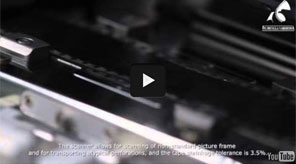
Digitalisation consists in the conversion of analogue images, frame by frame, into digital data in the process of scanning. Each frame is saved as a separate file, forming a sequence of image files.
The digitalisation performed within the framework of the project is aimed to preserve nitro-based film materials: images are transferred onto digital media to ensure their protection and availability. Digitalisation involves converting analogue images, frame by frame, into digital data in the process of scanning. Each frame is saved as a separate file, forming a sequence of image files.
A nitro tape is a substance with a natural tendency to be unstable. Once its decomposition process begins, it cannot be stopped. Therefore, the only solution is to copy the image. The traditional method of optical copying onto a new tape is extremely difficult due to considerable shrinkage and depleted perforation. Such a procedure may prove to be ineffective in the case of a badly worn and decomposing nitro tape, since all defects are copied too. Apart from that, optically copied films cannot be reconstructed digitally or converted into other formats. This is why the digitalisation offers the best solution, since the transferred image information is recorded on a digital matrix, it becomes "frozen" and the image destruction process can be considered stopped. Such a digital copy may already be reconstructed on digital media. Unlike the physical and chemical processes that are involved in the creation of an image on a photosensitive tape, computer technologies enable us to fully control a digital copy, with an accuracy of up to a millionth part of a single film frame.
Another unquestionable advantage offered by these technologies is that we can access an item, while leaving the original intact. The resulting digital copy can be recopied into different formats - in a file or video tape form, or transferred onto a polyester-based film tape.
|
|
The creation of a digital backup copy poses two fundamental problems: the very condition of the nitro tape (depleted perforation, shrinkage, etc.) and the establishment of digitalisation parameters. In contract to a digital image, which contains a clearly-defined, countable number of dots, the resolution of a photochemical image on a 35 mm tape is difficult to define in numbers. The image on a film tape is created by unevenly distributed silver particles, producing a characteristic aesthetic effect of film grain and optical density. Since the number and distribution of these grains is different in particular frames, grains cannot be directly translated into pixels.
Despite these dilemmas, there is no doubt that, to secure a film for archiving purposes, it should be scanned at a very high resolution and bit depth, with the largest possible amount of information about tonal gradation being recorded. By saving the maximum amount of information about the image, we protect the authenticity of a film material in its digital form. In particular, it must be done with nitro tapes which are unlikely to be ever digitalised or copied again due to their progressive degradation.
The films covered by the project are to be scanned at the 4K standard resolution and images are to be encoded in the DPX format - a loss-free format that makes it possible to record large amounts of information on optical density, with the characteristics of the source film base being well preserved.
















